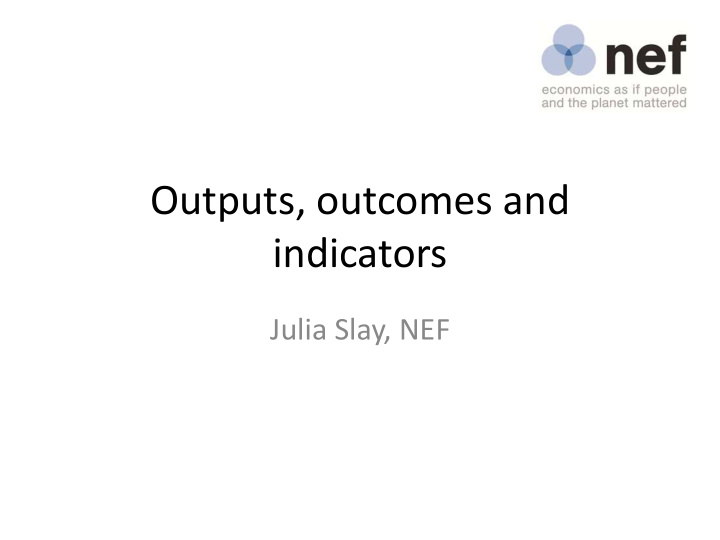



Outputs, outcomes and indicators Julia Slay, NEF
Introductions around the room
The first distinction: outputs Outputs Outputs are a quantitative summary of an activity. For example, the activity is ‘we provide training’ and the output is ‘we trained 50 people to NVQ level 3’. An output tells you an activity has taken place. Activity Output CV checking drop ins Number of people getting support with their CV Parenting skills classes Number of people attending parenting skills classes Cardio vascular health checks Number of health checks conducted
The second distinction: outcomes Outcomes • The change that occurs as a result of an activity (e.g. improved well-being of training participants) • Certain projects might lead to chains of linked outcomes … • Sometimes it takes years for outcomes to take place – for example, slowing the rate of climate change – but there may be observable changes along the way. You may have heard this described as distance travelled, intermediate outcomes, or a chain of events.
Indicators • It is important to think through indicators that can tell you both – whether the outcome has occurred – and/or, by how much (distance travelled) • It can be helpful to have a combination of subjective and objective indicators • Stakeholders are often the best people to help you identify indicators, so ask them how they know that change has happened for them
Examples of Indicators • Indicators are ways of knowing that change has happened
Holy Cross Centre Trust’s theory of change
Activity 1 Outputs, outcomes and indicators exercise (15 minutes) Outputs Outcomes Indicators Direct results of Change in people, Ways of knowing that change your activity, communities, the has occurred and that often countable economy or environment outcomes are being, or have e.g. no. people created wholly or been, met. receiving a partially by the training organisation. exercise.
Some of Kent’s Outcomes • Connected to their communities and feel less lonely and socially isolated • Have choice, control, and feel empowered • Report and optimise physical and emotional wellbeing • Live safely and independently and optimise recovery • In stable accommodation and managing their life • Achieve economic wellbeing - ensure people’s income is maximised, debts are managed and where appropriate applicable welfare benefits are accessed • Feel satisfaction with service delivery and service outcomes • Involved in service design, service offer and availability • Access a wide range of opportunities to support their personal recovery • Stay in or enter employment • With long term conditions supported to be independent and manage their conditions • Have increased social skills • People recovering from mental illness need to be appropriately supported
Kent’s strategic outcomes – Children and young people in Kent get the best start in life – Kent communities feel the benefits of economic growth by being in-work, healthy and enjoying a good quality of life – Older and vulnerable residents are safe and supported with choices to live independently
Camden’s Outcomes Framework
Measuring outcomes • It is important to think through indicators that can tell you both – whether the outcome has occurred – and/or, by how much (distance travelled) • It can be helpful to have a combination of subjective and objective indicators • Stakeholders are often the best people to help you identify indicators, so ask them how they know that change has happened for them
Poor practice ‘In March we awarded 37 attendance certificates to girls. These were given to 22 different girls, meaning that 13 girls had perfect attendance in 2 separate activities and 1 had perfect attendance in 3. At the end of year party, we awarded 31 certs to 23 different girls, 8 of whom had perfect attendance in 2 activities. We also gave awards to 12 girls who had 100% attendance in mentoring. 55% of all girls attended at least 80% mentoring sessions’
Better practice
Case studies • I. feels better able to talk to her mum and dad about her problems. She feels she gets on better with other children and she feels better able to stand up to other children • A. still finds it difficult to talk to mum and dad about how he feels. He also struggles to tell others what he is good at. He does, however feel better at making friends and standing up to them.
Further resources • Measuring well-being: a guide for practitioners. http://www.neweconomics.org/publications/ entry/measuring-well-being • Valuing social outcomes: http://www.nef- consulting.co.uk/our-services/evaluation- impact-assessment/sroi-centre-of-excellence/
Sector Training, Advice and Mentoring Programme (STAMP) • Social Enterprise Kent • In partnership with 4 CVSs & APEK • Service began 1 st October
Sector Training and Mentoring Programme KCC (public health and adult social care) and the Kent CCGs have commissioned this service to: • Support the sector to build and develop the skills they need for the future • encourage growth and diversification of the sector • encourage the development of partnerships and collaborations In order to support the transformation of KCC
STAMP Process 19
More Information • http://www.sekgroup.org.uk/stamp- main/4586343407 • Or call them on 01227 469970 20
Recommend
More recommend